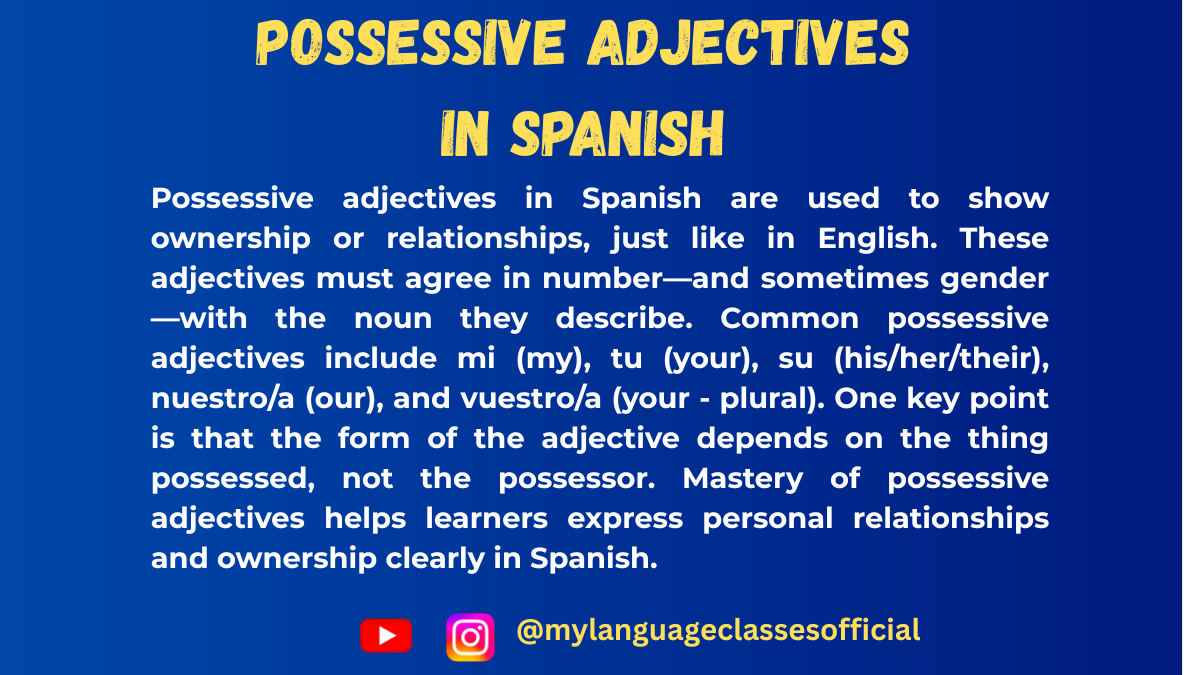Your cart is currently empty!
Tag: Nuestro Vuestro
-

Possessive Adjectives in Spanish
Mastering Possessive Adjectives in Spanish
¡Hola, amigos! If you’re diving into the beautiful world of Spanish, understanding possessive adjectives is a must. These small but powerful words allow you to express ownership and connection, and they’re used all the time in daily conversation. As an expert Spanish teacher and YouTuber, I’m here to break them down for you in a way that’s easy to understand. Let’s get started!
What Are Possessive Adjectives?
Possessive adjectives in Spanish are words that indicate to whom something belongs. Unlike English, Spanish possessive adjectives agree in gender and number with the noun they describe. Here are the main ones you’ll need to know:
Singular Possession Plural Possession mi (my) mis (my) tu (your, informal) tus (your, informal) su (his, her, its, your, formal) sus (his, her, its, your, formal) nuestro/a (our) nuestros/as (our) vuestro/a (your, informal Spain) vuestros/as (your, informal Spain) su (their, your, formal) sus (their, your, formal)
Key Characteristics of Possessive Adjectives
- Agree with the Noun, Not the Owner
In Spanish, possessive adjectives match the gender and number of the noun they describe, not the person who owns the object. For example:- Mi libro (My book) → Mis libros (My books)
- Nuestro coche (Our car) → Nuestra casa (Our house)
- Informal vs. Formal “Your”
- Use tu/tus for informal situations (talking to friends, family, etc.).
- Use su/sus for formal situations (talking to strangers, superiors, etc.).
- “Vuestro” is Only Used in Spain
If you’re in Spain, you’ll hear vuestro/vuestra/vuestros/vuestras for “your” in informal plural situations. In Latin America, people stick to su/sus for both formal and informal plural forms.
Examples in Everyday Context
1. Mi/Mis
- Mi casa es tu casa. (My house is your house.)
- Mis amigos son increíbles. (My friends are amazing.)
2. Tu/Tus
- ¿Dónde está tu teléfono? (Where is your phone?)
- Tus ideas son brillantes. (Your ideas are brilliant.)
3. Su/Sus
- Su coche es rápido. (His/her/your car is fast.)
- Sus libros están en la mesa. (His/her/your books are on the table.)
4. Nuestro/Nuestra/Nuestros/Nuestras
- Nuestro perro es muy lindo. (Our dog is very cute.)
- Nuestras familias están cenando juntas. (Our families are having dinner together.)
5. Vuestro/Vuestra/Vuestros/Vuestras
- ¿Es vuestro jardín? (Is this your garden?) [Used in Spain]
- Vuestras mochilas están aquí. (Your backpacks are here.) [Used in Spain]
Common Mistakes and How to Avoid Them
- Forgetting Gender Agreement
Beginners often forget to match the possessive adjective to the noun’s gender. Remember:- Nuestra for feminine singular (nuestra casa).
- Nuestro for masculine singular (nuestro coche).
- Mixing Formal and Informal “You”
- Don’t confuse tu (your) with tú (you).
- Example: Tu libro está aquí, tú lo olvidaste. (Your book is here; you forgot it.)
- Using the Wrong Plural Form
Always use the plural form of the possessive when describing multiple items:- Correct: Mis zapatos están en la entrada. (My shoes are at the entrance.)
- Incorrect: Mi zapatos están en la entrada.
Tips for Mastering Possessive Adjectives
- Practice with Real-Life Contexts
Try labeling items around your home. For example: mi teléfono, tu lámpara, su silla. - Listen and Repeat
Watch Spanish YouTube videos or listen to podcasts. Pay attention to how native speakers use these adjectives in context. - Interactive Exercises
Create sentences with different possessive adjectives and have a friend or teacher check them. For example:- Mi madre cocina muy bien. (My mother cooks very well.)
- ¿Dónde están tus llaves? (Where are your keys?)
- Create a Song or Mnemonic
Memorizing can be fun! Make a short song with the possessive adjectives or a catchy rhyme.
Final Thoughts
Mastering mi, tu, su, nuestro, vuestro is an important step in your Spanish-learning journey. With consistent practice and exposure, you’ll use them naturally in no time. ¡Buena suerte y sigue practicando! (Good luck and keep practicing!)
If you found this guide helpful, I’d love to hear from you! Share your thoughts in the comments below or connect with me on social media. For more tips, resources, and inspiration, visit my blog at mylanguageclasses.in. Follow on Instagram and subscribe on YouTube
📚 Continue Learning Spanish
- Agree with the Noun, Not the Owner
